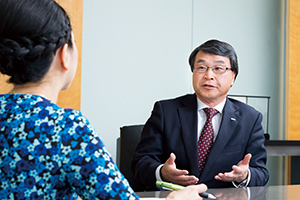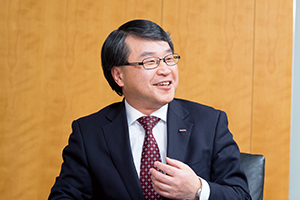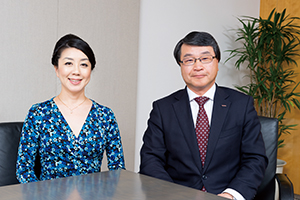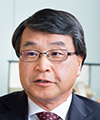Leveraging close contact with customers to develop new services
—Mr. Onoe, please tell us about the business environment surrounding NTT DOCOMO.
The last few years have seen severe competition in the business environment, but financial results for the third quarter of fiscal year 2015 showed an operating revenue of 3383.5 billion yen and an operating income of 685.5 billion yen, or a year-on-year increase of 1.7% and 16.8%, respectively, showing that the company has achieved two consecutive quarters of growth in both revenue and income. The Smart Life domain has been expanding favorably, and cost management such as in the area of capital investments is becoming increasingly more efficient. At the beginning of this fiscal year, NTT DOCOMO rolled out its “+d” initiative that aims to deliver new value to its customers through co-creation with partners. The plan is to make significant contributions to society under the themes of “solving social issues” and “revitalizing regional economies.”
Combining the strengths of our partners with the diverse business assets of NTT DOCOMO creates new value. Being in charge of research and development (R&D), I also think in terms of “+d” from an R&D perspective. When we hear the words “NTT DOCOMO asset,” perhaps the first thing that comes to mind is a business-like asset such as a customer base, but a technology asset can be just as valuable. Co-creation on the R&D side is already occurring in unexpected areas and producing results toward new business opportunities.
To give an example, NTT DOCOMO’s natural-language dialog platform technology developed for the Shabette Concier voice-agent service and other applications has been incorporated in the OHaNAS interactive conversational toy robot developed jointly with TOMY Company, Ltd. The business environment is still as competitive as ever, but I would like to create a virtuous cycle in which the growth of NTT DOCOMO itself results in the continuous provision of even better services for our customers.
—NTT DOCOMO has prospered despite the severely competitive environment—where do its strengths now lie?
Being a corporate enterprise, NTT DOCOMO must continue to generate profits, but on the other hand, it must also invest in the future. In a highly competitive environment, investment in the future would tend to be restricted, but I believe that the engine for achieving continued corporate growth into the future is R&D. For the past few years, we have been reviewing the methods used in R&D and working to make operations more cost-effective, and it is exactly because there are restrictions here that we have had to come up with new ideas and approaches. As a result, I believe that we have restructured ourselves in a way that enables us to produce R&D results in an ongoing and efficient manner.
Nevertheless, determining how much to invest and what to research in advance is difficult, to say the least. As you know, the range of R&D at NTT DOCOMO is quite broad, spanning the improvement and expansion of existing services as well as network operations and technical support. While it is necessary to continue our existing technology development efforts building upon past results, I also intend to prepare a growth engine that looks five years and more into the future taking technology trends into account.
Regarding the infrastructure development, NTT DOCOMO is focusing on the fifth-generation mobile communications system (5G), enhancement of the LTE-Advanced system, and network functions virtualization (NFV). We are proud of our role as a global leader in third- and fourth-generation (3G and 4G) system development, and we now have our sights set on deploying 5G services by 2020. In fact, we are conducting experiments and trials in cooperation with leading global vendors to contribute to the standardization of 5G technology.
The key issue here is how to go about creating new services. There are great expectations that the Internet of Things, big data, and artificial intelligence (AI) will lead to new business opportunities. NTT DOCOMO has been involved in this area from early on, and some services of this type are already being offered to customers. The natural-language dialog engine that was first used in Shabette Concier has undergone further development by incorporating NTT research results to the maximum. These efforts led to the development of the OHaNAS robot that I mentioned. In this way, I believe that the way NTT DOCOMO maintains close contact with customers when creating new services is a key strength.

Moving forward with a global view 20 years into the future—contributing to the world with 5G
—Where is NTT DOCOMO headed in the years to come?
As you know, NTT DOCOMO’s origins are in the mobile world. Up to the second-generation mobile communications system, specifications tended to be fragmented among countries and carriers, but from 3G on, it has been the earnest desire of the mobile industry to implement a common system worldwide. In this regard, 3G and LTE certainly played a role in achieving a world standard, but it was NTT DOCOMO that was recognized as a world leader in this process. Our R&D achievements are one reason for the high marks we have received, especially from parties overseas. Government ministers in Europe have been known to come here to visit our top executives largely because of our R&D. Of course, gaining such praise or respect is not our objective. Our aim through R&D is to make business-related contributions and to provide our customers with even better services.
On the other hand, the mobile industry on the whole has a very low reputation worldwide. Despite efforts at making people’s lives more convenient and contributing to society through mobile communications, the reality is that these efforts are not generally recognized. To rectify this situation, I would like to demonstrate to the world in concrete ways just how useful mobile technology can be to society and how it can contribute to the entire world community.
Recently, on the occasion of the Miss International Beauty Pageant held in Tokyo, we asked contestants from various countries to trial the 5G mobile communications technology. We received many messages expressing positive reactions such as “I would love to be able to use 5G in my country soon” and “I want 5G to change the world for the better,” even from contestants representing regions having a relatively low penetration of mobile phones. Such reactions made us feel that 5G is generating great expectations from a wide range of people throughout the world, and we came away with a strong sense of responsibility to contribute to the world through 5G technology.
To date, the mobile industry has witnessed the birth of a new generation of technology about every ten years, and the immediate target is the launch of 5G in 2020. In Japan’s advanced mobile communications market, the 1G and 2G systems discontinued operations after 20 years, reflecting a relatively quick transition in technology. Worldwide, however, history has shown that the diffusion of a certain generation of mobile technology peaks at the 20-year mark. We can say, therefore, that the development of a new generation of technology brings maximum benefit to the world 20 years later.
Technology trends in terms of infrastructure evolution can be predicted five or ten years into the future to some extent. However, I can honestly say that predicting the state of services five years from now is difficult. There are those who simply say that innovation does not occur in large corporations. However, I believe that services are about to become a very important area, and it’s my aim to create an environment to achieve a lot of innovation at NTT DOCOMO. With the aim of creating new services using a mechanism different from that used for existing services, I have made organizational changes and put into place a new system and development process. Here, an open development environment is crucial, and we are working on creating new value centered about passionate and enthusiastic developers through collaboration with parties on the outside.
Returning to the topic of 5G, I can say that initiating studies on new generation technology generally gives rise to negative reactions, as in questioning the need for changing to a new generation when the current generation is still generating revenue and pointing out that constructing a new infrastructure will incur massive expenses. When studies on 3G were beginning, some people would ask, “What would a data rate of 2 Mbit/s be used for?” and in the case of LTE, a common question was “Is a rate of 100 Mbit/s really necessary?” NTT DOCOMO takes the initiative in technology development and makes investments where needed. Once a person has been placed in a pleasant environment and becomes accustomed to it, there’s no turning back! When a more convenient environment is provided, a virtuous cycle will arise in which users come up with usage methods appropriate to that environment. In this way, people are now enjoying one of the world’s leading mobile environments that we created. There is much excitement about 5G at such an early stage that the standardization discussion has not yet started. This is more than we expected, but in the period leading up to 2020, my goal is to make steady progress in developing 5G technology without losing any of that excitement.
There is one more thing concerning a dream of mine that I would like to purposely express to the outside world. I believe that the base technology of mobile phone systems, that is, cellular technology, will come to be used in all sorts of use cases and will eventually become the dominant communication technology. For the time being, we can expect a number of technologies to be used and operated in a complementary and coordinated manner, but my dream is that they will all converge to cellular technology one day. On the other hand, as we look out over a long time span of say 30 years, the reality is that cellular technology might again diverge into some different technologies. Over the next five years, however, I am confident that the various technologies now in use will converge to LTE-based cellular technology.

Easily achieved results soon become commonplace. Set targets that even you may have doubts about!
—Mr. Onoe, you are sometimes called the “father of LTE.” Can you leave us with a message for the engineers working under you and all NTT DOCOMO employees?
I would be happy to. The emotional argument that “a person with passion can do anything” certainly is not true all the time, but it is very important that you continue to bring passion to your work. While this depends somewhat on each person’s temperament, having a desire to seek out challenging themes and big dreams with persistence is important in an engineer. Looking back at myself in the past, I would say that perhaps I was like that, but only in the sense that I would become totally absorbed in the problem before me. However, through experience, I came to understand the importance of setting somewhat high targets. If you set a low hurdle for yourself, you will be able to achieve something very soon, but whatever it is that you developed will soon become commonplace and conventional.
I believe that “things that appear impossible” and “things for which people have doubts about” are ideal as five-year targets. In relation to 5G, I will usually tell my research team to achieve something difficult that even I myself have doubts about it. For example, I have told them that I want us to aim for a cellular system that can deliver signals up to a distance of 1 km even if using high frequency bands, despite the fact that I actually feel that only half that distance is feasible. In my experience, when I become absorbed in a project while thinking “there is no way that this can be done,” I have sometimes experienced utter surprise when it turns out to be doable, exclaiming “What? It worked!”
The capability of doing anything on our own is sometimes referred to as being in the NTT Group’s DNA. However, we will enter an era in which we cannot survive if we are not quick to adapt to changes in vendor and operator relations and in technologies and ecosystems while thinking closely about what we ourselves should be doing and where we should focus our energy. In today’s world, technology tends to be controlled by vendors, but displeasure with this situation can be heard from operators. I want NTT DOCOMO to continue to have a big impact on the world and to be obsessed in a good way about doing so. In this endeavor, it is crucial that we know our customers better and have a global perspective. It is nonsense to think about what to create by looking only at Japan without learning about things going on in the outside world. With these ideas in mind, I would like all engineers and employees to think for themselves and let their opinions be known and to adopt the spirit of a world leader in their field.
Finally, I would like us to develop close links with the R&D departments within the NTT Group. We can expect NTT laboratories to have top-level technologies in the security field and elsewhere. I want to create services that change the world through intra-group collaboration that facilitates the mutual use of superb technologies. We need to form closer and stronger ties. And there are key areas being driven by NTT DOCOMO, too such as AI-based interactive and translation technologies, platforms for location-information services, and NFV. Going forward, I want us to develop strong collaborative practices to maximize the value of the entire NTT Group!


